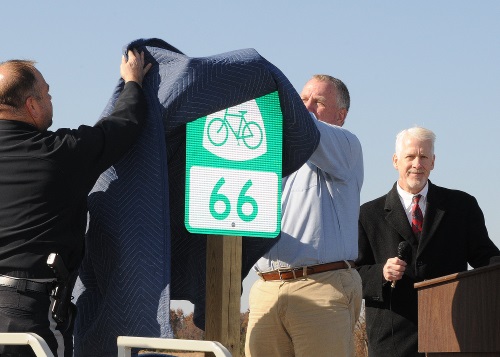As the novel coronavirus shuts down most personal interactions across the country, state departments of transportation are witnessing a transportation shift – rush hour is gone, passenger vehicles are gathering dust, and people are walking and biking.
States from Colorado and Indiana to Maine are reporting highway traffic decreases of 40 percent to 50 percent. Walking and biking increases are harder to quantify, but the Rails-to-Trails Conservancy reported that active transportation trail usage was up nearly 200 percent for the week ending March 22 compared to the same time period in 2019.
Even after life gets back to “normal” and highway traffic resumes, active transportation likely will play a larger part in many state DOTs.
“It may inspire us all to think outside the box about transportation policy, planning and investments,” noted Matt Bruning, press secretary for the Ohio Department of Transportation.
It didn’t take a global pandemic for officials in Ohio to recognize that walking and biking aren’t just recreational activities. An Ohio DOT survey released in January showed 78 percent of respondents are interested in or already use a bike to commute or to run errands, while 79 percent said they are interested in or already are walking to school, work and other destinations.
The survey is part of Walk.Bike.Ohio; an in-progress plan to develop statewide active transportation policies. The plan, scheduled to be completed by year’s end, “will drive our priorities, our decisions and our investments,” Bruning said.
While Ohio is now building a walking and biking policy framework, the California Department of Transportation’s Active Transportation Program or ATP has been in place since 2013. Since then, Caltrans has funded more than 800 urban and rural biking and walking projects. In fact, in the upcoming biennial budget cycle, about $440 million has been allocated to the ATP.
While not all state DOTs have California’s fiscal muscle, starting an active transportation program isn’t necessarily about the money, according to Laura Crawford, who coordinates biking projects for DOTs at the Adventure Cycling Association (ACA).
“The big barriers we see to states’ developing a program are usually the political climate and staff resources,” Crawford said. “If this is something a DOT is interested in doing, but they don’t have the staff resources, ACA can fill that role by managing volunteers.”
Crawford’s focus is on the U.S. Bicycle Route System, a series of national corridors for bicycles. She works with AASHTO’s Special Committee on U.S. Route Numbering, which provides consistency in route numbering similar to the interstate system. So far, more than 14,000 miles of routes have been established and signed in 27 states and Washington, D.C. The system’s growth is driven by state DOTs, each of which uses its own criteria to designate safe bicycle routes, Crawford said.
Kevin Mills, Rails-to-Trails’ vice president of policy, noted that the old attitudes of, “Well, we’ll build something for [active transportation] when we’ve got time to do it,” have changed.
“Really, that transformation is already underway and we’re seeing more state DOTs elevating active transportation as a real option,” Mills said. “When you think of the classic objectives DOTs have to meet the mobility needs of its citizens, this is a real bargain.”

